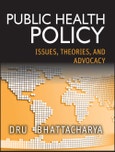Public Health Policy: Issues, Theories, and Advocacy offers students an engaging and innovative introduction to public health policy: its purpose, how it is originated, and how it is implemented. The book describes the underlying theories and frameworks as well as practical analytical tools needed for effective advocacy and communication. Drawing on the multidisciplinary nature of public health, the book uses concepts and examples from epidemiology, law, economics, political science, and ethics to examine the policymaking process, explain positions pro or con, and develop materials for various audiences to further a public health policy intervention. In addition, Public Health Policy shows how policymaking is a complex and integrated top-down and bottoms-up process that embraces a myriad of public and private stakeholders.
Written by a highly experienced health policy researcher and teacher, the book is rich in resources that will enhance teaching and learning. Each chapter begins with an overview of the chapter, including core terms and concepts, and includes illustrative examples of how the highlighted component (law, ethics, economics, politics, epidemiology, and medicine) intersects with public health. Discussion questions at the end of every chapter, along with an interview from an expert from each of the component fields, give real-world perspectives on how that particular subject relates to the overall topic. The book also contains 13 case studies that illustrate the framework discussed in the first part of the book, and show how the different components link to create, sustain, evaluate, or obstruct the development of public health policy. Also included are primers on two essential policy tools: how to write research policy briefs, and how to craft effective letters to an editor, including examples of both drawn from the author's publications in journals and newspapers.
Table of Contents
Introduction vii
The Author xv
PART 1 BUILDING A FRAMEWORK FOR CONDUCTING A MULTIDISCIPLINARY ANALYSIS
Chapter 1 The Role of Law: Agencies, Legislatures, Courts, and the Constitution 3
Chapter 2 The Role of Epidemiology and Medicine: Diagnosis, Prevention, Control, and Evaluation 45
Chapter 3 The Role of Economics: Theories, Modeling, and Evaluation 77
Chapter 4 The Role of Politics: Players, Processes, and Power 99
Chapter 5 The Role of Ethics: Historical, Contemporary, and Future Perspectives 141
PART 2 CASE STUDIES
Chapter 6 HIV Criminalization 181
Chapter 7 Clean Water Legislation and Mosquito Control 201
Chapter 8 HPV Vaccination 213
Chapter 9 SCHIP and Children with Special Health Care Needs 245
Chapter 10 Overweight and Obesity 265
Chapter 11 Breast Cancer Screening 285
Chapter 12 Medical Transportation: Local Research Focus 295
Chapter 13 Medical Transportation: Local Practice Focus 307
Chapter 14 Taxes, Politics, and Public Health Policy: A Look Back at the 2008 Presidential Campaign 327
Chapter 15 Supplemental Nutrition Assistance Program and Modifying Behavior 353
Chapter 16 Medical Readmissions and the Affordable Care Act 365
Chapter 17 Tobacco Control and Cessation Programs 389
Chapter 18 Emergency Preparedness and Infectious Diseases 403
PART 3 ADVOCACY
Chapter 19 The Research Policy Brief: A Primer 429
Chapter 20 Letters to the Editor: A Primer 467
Index 475








